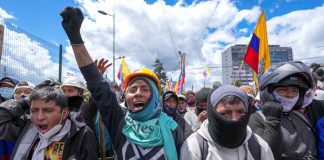In late December a wave of mass protests in Iran began that spread to all corners of the country. Spontaneous protests erupted in nearly 70 cities, many in provincial areas where there is high unemployment. At least 22 people have been killed by the authorities and more than 1500 arrested.
This is the largest display of public defiance since 2009—when protests against electoral fraud were brutally repressed. This time the revolt has been strongest in cities with a large impoverished working class.
The regime has hit back, deploying its Revolutionary Guards to savagely repress the movement.
The initial protest in Mashhad, Iran’s second largest city, was organised by regime hardliners in an attempt to undermine “reformist” president Hassan Rouhani. But it was taken over immediately by ordinary people looking to voice their frustration over unemployment and economic hardship.
The immediate catalyst for popular rage was the annual budget, where Rouhani’s government gave huge handouts to clerical institutions and the military while cutting subsidies for the poor. The economy has actually started to recover, following the easing of sanctions and the resumption of oil exports. But the mass of poor people have barely benefitted.
Price rises, including a 40 per cent jump in the price of eggs, unemployment officially at 12 per cent but in reality much higher, unpaid wages and rocketing rents have all made life harder. Many retirees haven’t received their pensions, and others have lost money because the banks went bankrupt.
Unlike those in 2009, the protests have raised slogans against both factions of the regime: the liberal “reformers” and the conservative hardliners. Despite its religious framework the Iranian regime is fundamentally capitalist. Both factions have imposed neo-liberal austerity and embarked on privatisation in an effort to attract foreign investors and restore relations with the West.
Chants have included both “Death to the Dictator”, targeting Supreme Leader Ali Khamenei and “Death to Rouhani”.
Protesters have also opposed Iranian government spending on wars in Syria and Iraq while ordinary Iranians suffer poverty, with chants including “Forget about Syria—think about us”.
There have been calls for independent trade unions, and the fall of the Islamist regime.
Women have been at the forefront of the protests, often defying the compulsory wearing of the hijab.
As in any real movement there are also conflicting ideas. There have been some nationalist slogans raised such as “Neither Gaza, nor Lebanon, I give my life for Iran” and “We are Aryans, we don’t worship Arabs”.
Don’t trust Trump
Donald Trump has positioned himself as a supporter of the Iranian masses. Nothing could be further from the truth. Iranians are among those banned from entering the US under Trump’s travel ban. He has slashed the refugee quota, and is intent on scrapping the deal over Iran’s nuclear program which has eased sanctions.
The Australian government also wants to keep out Iranian refugees, many of whom fled the regime’s crackdown on the 2009 protests. It has imprisoned hundreds of Iranian asylum seekers on Manus Island and Nauru.
Western governments are no friends of ordinary Iranians struggling for freedom. They simply hope to replace the Iranian regime with a government supportive of Western control of the Middle East.
But it is an insult to the brave protesters to present them as somehow manipulated by the US and Israel as the regime’s supporters are doing.
Workers’ movement
In the mass revolutionary wave that overthrew the Shah in 1979, workers played a central role, before Ayatollah Khomeini suppressed all expressions of independent working class organisation in an effort to restabilise Iranian capitalism.
Workers in Iran continue to resist the privatisation of the steel and oil industries, the widespread use of sub-contracting and the imprisonment of union leaders.
According to Agence France-Presse, “Minor protests have been bubbling away in the weeks leading up to the current unrest,” with “hundreds of oil workers and truck drivers protesting the late payment of wages; tractor makers in Tabriz against their factory’s closure; and Tehran tire workers at bonuses being delayed.”
A successful uprising in Iran could undermine the bitter sectarianism between Shia and the Sunni that has riven the Middle East over recent years. Syrian and Egyptian revolutionaries for example, have already been inspired by the revolt. Egypt in particular, which was at the heart of the Arab Spring of 2011, has a large working class that has fought to build independent trade unions.
A mass uprising of the Iranian working class demanding freedom and an end to inequality would inspire workers across the region to fight their own ruling classes.
By Mark Goudkamp





